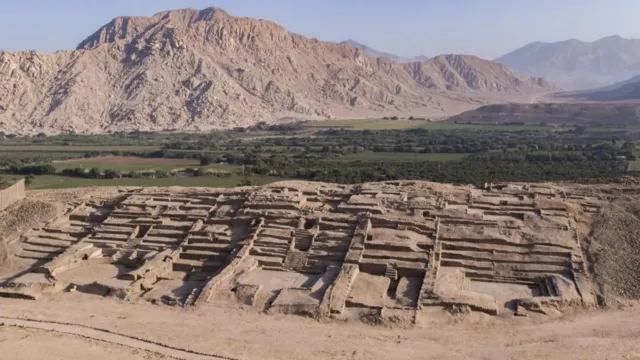Archaeologists Unearth 3,500-Year-Old City in Peru, Revealing Insights into Early American Civilization
In a groundbreaking discovery that promises to deepen our understanding of early American civilizations, archaeologists have announced the unearthing of a 3,500-year-old city in Peru’s northern Barranca province. Dubbed “Peñico,” this ancient settlement is believed to have played a pivotal role as a vital trading hub, fostering connections between the early communities of the Pacific coast and the inland populations of the Andes mountains and the Amazon basin.
The city of Peñico, situated approximately 200 kilometers (124 miles) north of Peru’s capital, Lima, lies at an elevation of about 600 meters (1,970 feet) above sea level. Preliminary dating suggests its founding between 1800 and 1500 BC, a period that coincides with the flourishing of early civilizations across the globe, including those in the Middle East and Asia. This temporal parallel highlights the advanced societal developments occurring independently in the Americas during this era.
The discovery of Peñico offers crucial insights into the legacy of the Caral civilization, recognized as the oldest known civilization in the Americas. Caral, established around 3000 BC in the Supe Valley of Peru, predates Peñico by several centuries. The new findings are expected to shed light on the evolution and eventual fate of the Caral society, particularly in the context of environmental challenges.
Drone footage captured at the site reveals a striking circular structure situated on a terraced hillside at the city’s core. This central feature is surrounded by the remnants of stone and mud-brick buildings, indicating a well-organized and substantial urban settlement. Over eight years of dedicated research at Peñico, archaeologists have identified and excavated 18 distinct structures, encompassing both ceremonial temples and residential complexes, providing a comprehensive glimpse into the daily lives and spiritual practices of its inhabitants.
Among the significant artifacts unearthed within the buildings are ceremonial objects, intricately crafted clay sculptures depicting human and animal figures, and decorative necklaces fashioned from beads and seashells. These findings underscore the Caral civilization’s advanced artistic and spiritual traditions, as well as their extensive trade networks, which likely facilitated the acquisition of materials like seashells from coastal regions.
Dr. Ruth Shady, a renowned archaeologist who led both the recent research at Peñico and the groundbreaking excavation of Caral in the 1990s, emphasized the discovery’s importance. She stated that understanding Peñico is key to comprehending the trajectory of the Caral civilization, especially after it was significantly impacted by climate change. The strategic positioning of Peñico, as Dr. Shady noted to Reuters, “situated in a strategic location for trade, for exchange with societies from the coast, the highlands and the jungle,” highlights its crucial role in interregional connectivity.
Further elaborating on the significance of Peñico, archaeologist Marco Machacuay, a researcher with Peru’s Ministry of Culture, remarked at the press conference unveiling the findings that the city represents a vital continuation of the Caral society. This perspective challenges previous notions about the civilization’s decline and suggests a more nuanced transition and adaptation in response to changing environmental conditions.
Peru is a treasure trove of archaeological wonders, home to globally significant sites such as the Inca citadel of Machu Picchu nestled in the Andes mountains and the enigmatic Nazca Lines, ancient geoglyphs etched into the desert landscape along the central coast. The discovery of Peñico adds another critical layer to Peru’s rich historical tapestry, offering fresh perspectives on the ingenuity and resilience of its earliest inhabitants.

